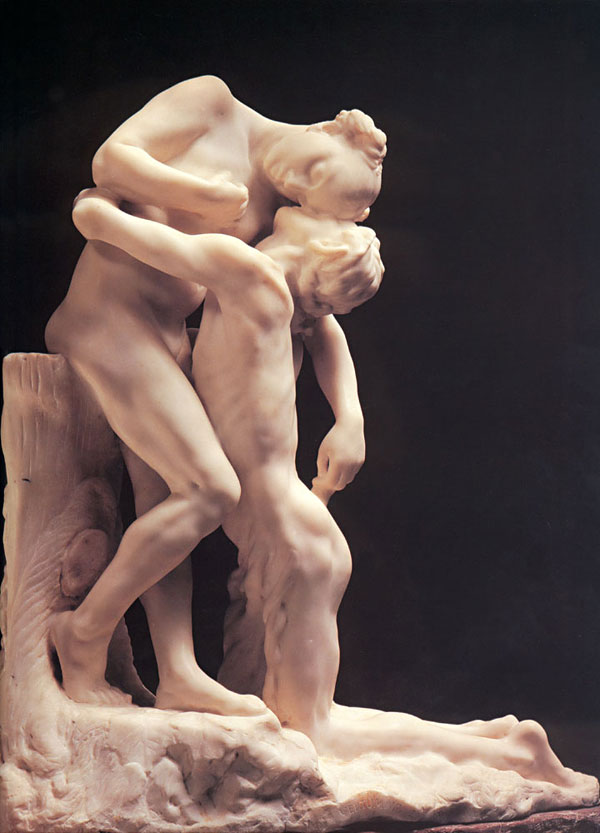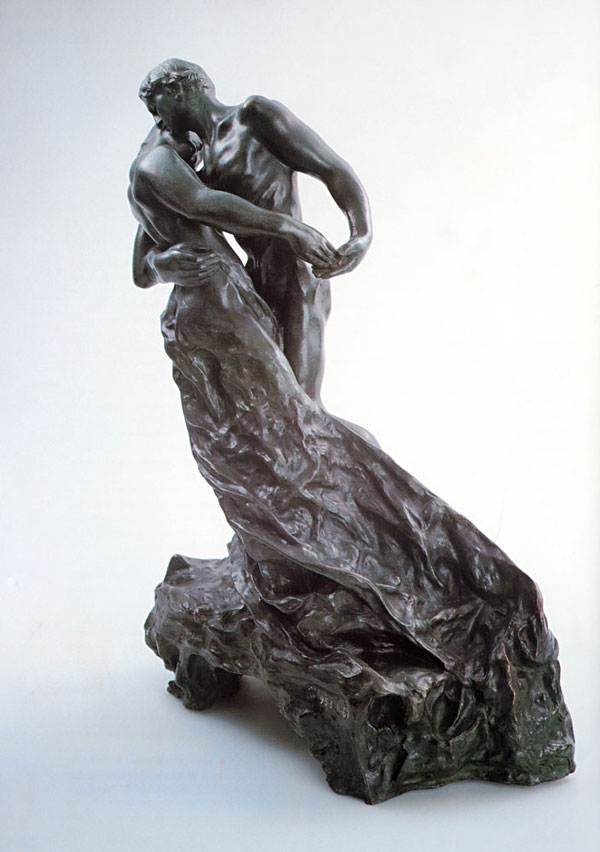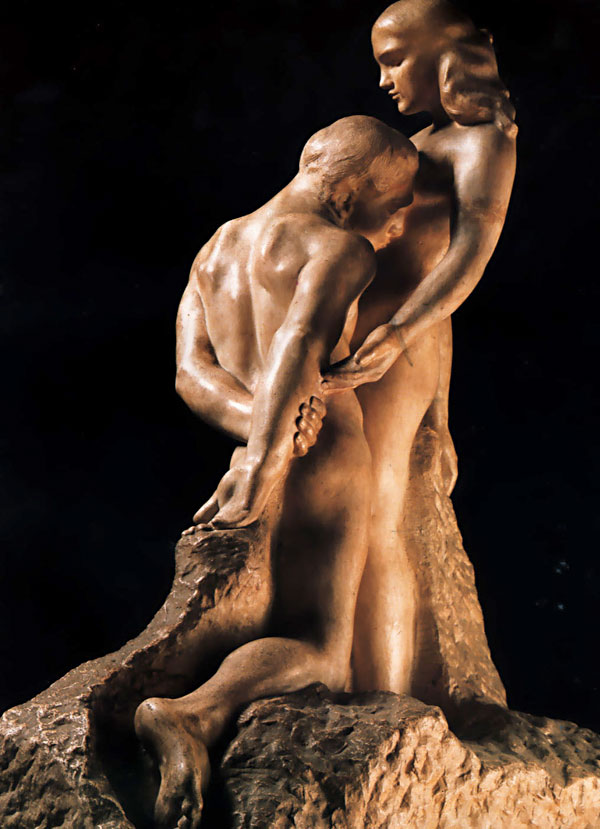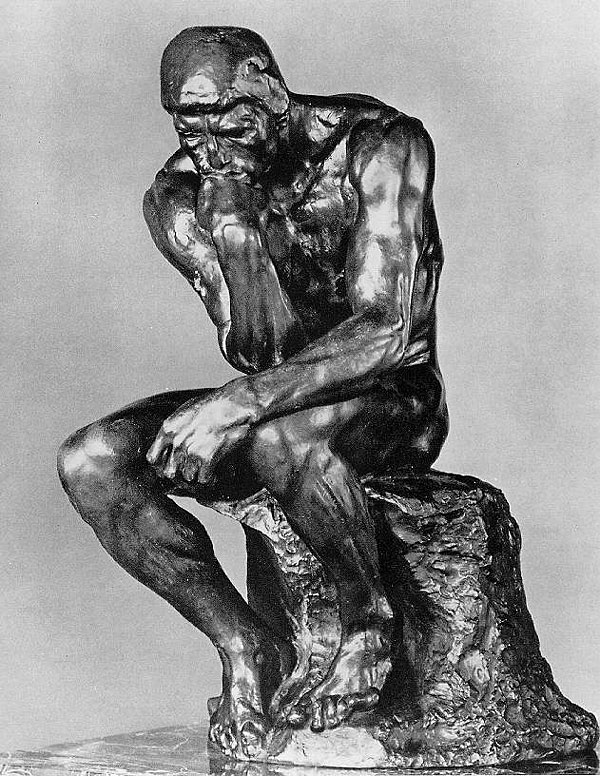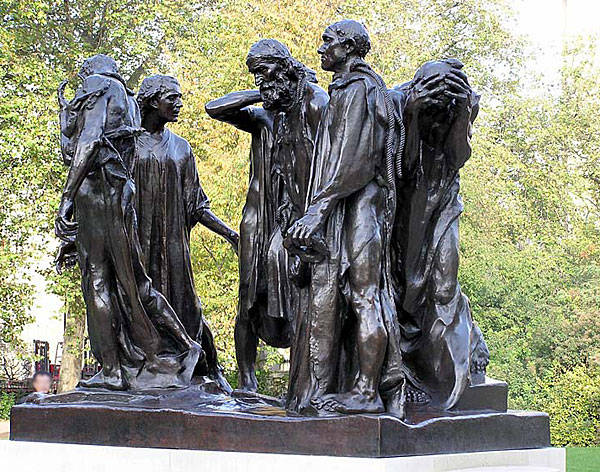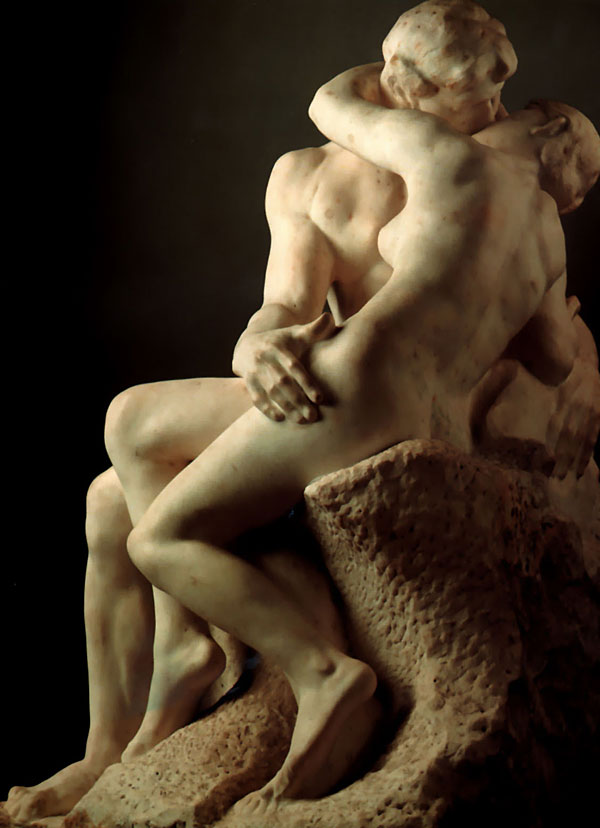Dear Artist,
Artists of all stripes can learn something from Auguste Rodin. As in the work of Michelangelo, to whom he was indebted, Rodin’s sculptural material is often cut away only to the degree that it’s creatively needed. This unfinished and rough aspect is a virtue — the hand of the artisan allows viewer participation in the art process. Also, simplifying shapes and means of expression increases an artist’s opportunity for direct emotional impact.
It’s this “in one” contrast that makes figures like The Thinker so viable. The athletic physique is transfixed by the intense capability of the inner man. It’s a brilliant example of body language. In another exemplary piece, The Kiss, the female figure is submissive and yet delicately responsive. The male, in contrast, is powerful yet gentle, his fingertips resting tentatively on her thigh.
Rodin used caricature and exaggeration to emphasize and bring life to his ideas. Brutality is depicted with outsize hands, veins, stressed musculature, distressed sinews. Age is shown with the weary slump of the material — sag, bloat and disfigurement. Youth with simplicity and innocence of finish. Love with palpable eagerness made more so by the absence of distracting detail.
In the tragic Burghers of Calais a state of confusion is implied by the irregular arrangement of the figures. These are people in an extreme emotional crisis, their faces perplexed by immanent doom. Rodin’s is an intense personal expression of elemental power — even the hasty modeling of the clothing seems to show anguish and stress. Through all this an observant student should note the very height of the action and the most telling gestures. It’s as if the sculptor took multiple photos of acting models and selected one as the quintessential. In order to get an idea of what I’m talking about, I’ve asked Andrew to illustrate these ideas at the top of this page.
Auguste Rodin (1840-1917) rose from disadvantaged circumstances and spent his first years designing tiles and masonry. In later life his sculpture and drawings were in high demand. Much has been made of the early rejection of his work by the French Academy and his liaison with Camille Claudel, and others. Whatever one might think of his life, Rodin was a master. “Work lovingly done,” he said, “is the secret of all order and all happiness.”
Best regards,
Robert
PS: “The Third Republic consumed art like nobody’s business. There was a perceived need for public iconic imagery to celebrate the secular spirit of the new bourgeois order in a style running on the fumes of Romanticism.” (David Duke)
Esoterica: Rodin indeed engaged a professional photographer, Gaudenzio Marconi. As well as photographing finished work, Marconi took multiple shots of models for Rodin to use at his leisure. Most notable is the attention to light and shadow, both soft and hard. Rotated sculpture, like rotated life, when lit consistently, picks up a moving montage of ever-changing patterns. Rodin was highly conscious of the “circumambulation factor.” Sculpture, unlike “wall art,” was meant to be circled.
Don’t take work too far
by Patty Grau, Redondo Beach, CA, USA
I’m a sculptor who idolizes Michelangelo and Rodin. In a bio of Rodin, I read a quote of his after he was in Italy, where he said, “Nothing is as beautiful as a beautiful ruin.” His meaning, it said, was that perfection depicted is just that. You observe it, digest it and move on. But the potential one sees in something that is not complete, whether the work is unfinished (as in Michelangelo’s Prisoners, or destroyed, as in the Coliseum) leaves it to the imagination to complete the work. I love this concept. I strive to not take my work too far. It’s very hard.
Camille Claudel and Rodin
by Sandy Nelson, Kitty Hawk, NC, USA
After visiting the Musee Rodin in Paris and seeing the maquettes of Rodin’s student Camille Claudel, he only ran a close second to his student. Her work is raw, explosively emotional, rough yet finished in its entirety. Even the small pieces have a mastery and monumentality I’ve not seen elsewhere. Even Rodin’s best efforts pale by comparison. No wonder he did nothing to support her efforts.
(RG note) Thanks, Sandy. The story of Camille is indeed tragic. A May-September affair, there was undoubtedly some abuse — whether it was induced by jealousy will never be known. Both were difficult people. She spent the last thirty years of her life in an asylum. The reported conflict inspired the 1989 movie Camille Claudel. It’s a long, romanticized version of the turn of the century art world and the changing roles of women — in French with subtitles — requiring thoughtful and attentive viewing.
Camille Claudel (1864-1943)
Rodin worldwide
by Lori Graham, Los Angeles, CA, USA
I just came home from spending three weeks in France. One of the highlights was the Rodin Museum in Paris. Your eloquent writings and perceptions made the museum come alive again. Thank you for your continuing inspiration and writing about art.
(RG note) Thanks, Lori. There are many places where Rodin can be seen. Readers might be aware of the temporary exhibitions in Vancouver, and Quebec City, Canada, and other places. Major collections are in Philadelphia and San Francisco. The late B. Gerald Cantor was the foremost collector and public donor of Rodin works. Many of these are in the outdoor sculpture garden at Stanford University in Palo Alto, Calif. The Burghers of Calais are at the Met in New York as well as in front of the parliament buildings in London, England. There are many Rodins in Japan and South Korea. The Spreckles Foundation has a large collection. Sculptures, remember, can be recast indefinitely without loss of quality. Everything Rodin is listed on the Rodin website. The best books on Rodin that I know of are Rodin, a Biography by Frederic V. Grunfeld and The Shape of Genius by Ruth Butler.
Sorcerer’s apprentice
by Kathy Ostman-Magnusen, Pahoa, HI, USA
Right now I work for an Italian sculptor. He’s designing a eight building complex to go to Mexico, all in Italian Baroque. He is even designing the furniture! He screams, cusses, throws things, stomps out of the room, fires people (2) for inappropriately timed jokes. I am of Swedish decent so my mannerism is softer. Ewwww! Sometimes he is just too much! Yet I know as time goes by, I am advancing and thinking past what I knew before. There are times when I wanted to tell Ermanno to (&*(^$$@#%$.) But I know that if I can hold out, if I can learn to get tougher and shed the difficult atmosphere he creates, I will grow. I will grow in my art and more importantly in my thinking. I will be stronger and prepared for higher hurdles. I will never know it all. There will always be new things to discover. I draw for him. I am not a draftsman nor have I ever thought past figurative work much — so this is a challenge. There is a part of me that is five years old who wants to take her crayons home. I cry often and feel so inadequate and of course abused. Back and forth, back and forth. Camille Claudel, the video, sub-titled, is one of my favorite movies. It shows the passion that fills up her veins as blood. She died on my birthday so I have always felt connected.
I used to be in the pottery business. The achievement of making a living and being in a position to hire eight other workers never seemed to be more of an asset ’til now. So many long nights of sitting there in a room until 2 a.m. making one more dozen mugs. I gave up a lot to make a living this way. Mostly being a better mother. But I gained the insight that art is something you do no matter how you feel. The inspiration comes simply by ‘showing up’ before the easel or sculpture stand. Out of practice means out of mind and that the passion is not there or at least appears to be disintegrating. I paint and sculpt because I have to. Like Camille I will go to any lengths to ‘get my clay’. My heart is chained to the reference of necessity of expression and creativity. Sometimes I feel it is eating me alive. While making pottery for twenty years lost its sense of creativity it did teach me to be focused. Sadly, my focus became robotic and enclosed. There was no time for anything else. I ceased to learn and to know that there was indeed more to life than what I saw from the tiny window. I am bombarded now with all the things I don’t know.
Rodin’s assistants
by Donna Arnold, Goshen, IN, USA
On a trip to Paris this spring we visited Rodin’s home and studio and were able to study the above mentioned sculptures first hand. Your descriptions are quite apt. While in the city we were told that Rodin did all the designing but that most of the sculpture was done by assistants (not Camille). Do you have any information on that?
(RG note) Thanks, Donna. Rodin often made small studies in clay that his assistants would reproduce in a larger size. More workers would make plaster casts and then — sometimes years later — the foundry would make more casts in bronze. Foundries, as many know, are labour-intensive places. Rodin’s was a veritable factory — his work was and still is in high demand. A good overview can be found on Rodin enthusiast Gregory Melle’s website.
Sold out
by David Wayne Wilson, White Rock, BC, Canada
Nothing is more irritating than a mere professional artist. When we look back into the history of art, the many ‘successful’ artists of their day are simply absent from the ‘great artists’ category, because they specified that their work entertain the buyers of the times. How would such people even get into the same category as real artists who happen to innovate, rather than mime? How many snobs would have bought The Potato Eaters unless they were assured that it amounted to a hell of an investment? I acknowledge that there are ‘professional standards’ but let’s discern between ‘professionalism’ and creativity. The moment someone other than the artist determines the ‘product,’ the product becomes a collaboration. How many signatures belong at the bottom of a collaboration?
Gentleman earnestly seeking studio
by Bernard F. Pracko II, Broomfield, CO, USA
I have spent the last year exploring parts of Slovakia, Hungary, UAE (Dubai), Albania, Ukraine, and some Western European locations where I might establish a non U.S. studio to live and paint. My research of the sacred feminine, the mystical in cultures in relation to their contributions to mankind, and historic flows of mythology continued in their various forms from culture to culture have taken me to the countries mentioned.
Would you know of studios or a method to find studios in various countries for short term (3-6 month) use? Old churches, large spaces (my current U.S. studio is 50′ x 50′ x 27′ high, lots of light, which accommodates several large pieces in progress at once. Alternatively, would you have advices on a location? My general preference is to settle in a climate which is temperate, near the ocean, near a city with art supplies.
(RG note) Thanks, Bernard. Studios Worldwide on our site takes you to some of these sorts of locations. Consider swapping studios.
A life of struggle
by Mary Jean Mailloux, Oakville, ON, Canada
According to Renoir, Cezanne was the greatest of the Impressionists. Cezanne risked everything and was not stopped by people who said he should have been a butcher. He struggled with composition, his sexual repression, lack of family support, learning the medium and the method by trial and error. Sales cannot be the only measure of accomplishment, and yet it is difficult to remain motivated when it always seems just beyond one’s grasp.
Biking and painting
by Laura Anderson, Billings, MT, USA
I have been trying to pack my French easel on my bike. In the Robert Genn Album section of the Painter’s Keys site I saw your picture working on your bike trailer easel — the “Art Dog.” I think I could build one if I could get a better look, but for whatever reason the computer won’t enlarge the picture of you painting with it all set up. At your convenience would you please send me this picture or any others that you might think helpful? Biking keeps me fit, painting keeps me sane.
Personalysis
by Lou Glist, Houston, TX, USA
In your recent letter regarding the state of messiness, I would like to add this bit of information gleaned from the work of James Noland in behavioral assessment. It’s called Personalysis.
In the jargon of his behavioral assessment which is designated on a matrix in the terms of colors — red, yellow, blue and green, the artist or creative person is in the blue quadrant. Of the blue behavior measured is the need to learn the why of things — a search for a meaning of life, strong empathy, ability to discuss one-on-one, the search for alternatives/other solutions, a conceptualizer has an imaginative rather than a cookie-cutter approach. All of the noted behavior are ideal for the artist. Blue people, he found, tend to be pack-rats and thrive in a higher degree of clutter than other colors. Noteworthy is that, in spite of the mess, they know where everything is. I am not an agent for this company, but a lifetime friend of the developer. I have personally taken a Personalysis and found it to be spot-on. I am as blue as possible and my wife complains about my clutter and messiness. But when it comes to the art stuff, I can go right to it.
(RG note) Thanks, Lou. I feel blue. Now where did I put that glue? For those who might like to find out about Personalysis, please go to Personalysis Corporation.
Auguste Rodin (1840-1917)
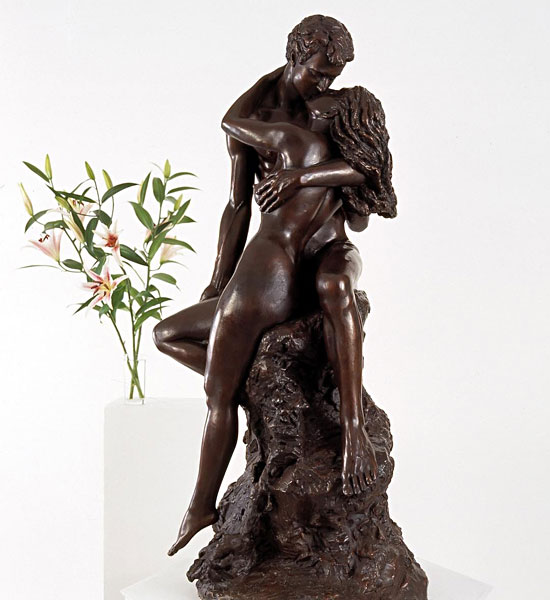
The Kiss bronze sculpture |
You may be interested to know that artists from every state in the USA, every province in Canada, and at least 105 countries worldwide have visited these pages since January 1, 2005.
That includes Carol Lyons who wrote, “I recommend reading The Fountainhead. Hardly a contemporary best seller, having been written in 1943, this novel is a modern classic. It’s as fresh today as it was then — the story of the ideal man who pursues his noble vision and potential.”



